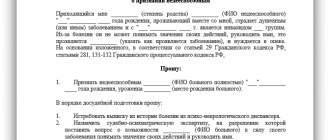Documents required to establish the origin of children
Two legal procedures can accurately establish the origin of a newborn child, which allow the newly born person to acquire a first and last name, as well as receive his first document:
- Establishment of paternity;
- Establishing maternity.
When performing such procedures, it is necessary to have documentation from the medical institution where the birth took place or certificates from non-medical organizations. When establishing maternity, the mother's application to the registry office is important.
The procedure for establishing paternity can be carried out automatically when the father of the child is recognized as the mother’s husband, or voluntarily when the father submits an appropriate application if the mother is not officially married to this person.
Which organizations should I contact to resolve the issue regarding paternal rights?
Issues related to the determination of parental rights are resolved with the mandatory involvement of the following organizations:
- Medical institutions;
- Medical examination institutions;
- MARRIAGE REGISTRY;
- Court.
If the parties to the proceedings reach a certain agreement regarding parental rights and responsibilities, the involvement of the court can be avoided. In situations where judicial intervention is required, it is necessary to contact a family law lawyer.
Was the Recording helpful? No 2 out of 3 readers found this post helpful.
Establishing the origin of children. Maternity registration
Establishing maternity is the most important stage in the life of every woman, which requires mandatory compliance with the legal procedure. According to the current legislation, in order to establish and register the fact of motherhood, it is enough for a woman to have the appropriate medical certificate when contacting the registry office, which will issue a special document
In the event of the death of the mother or her incapacity, maternity is established in accordance with documentation from the maternity hospital or additional papers from non-medical institutions. If there are disputes about the fact of maternity, the procedure involves appealing to the judicial authorities.
Grounds for establishing maternity
According to Art. 47 of the RF IC, the basis for mutual rights and obligations between children and parents is the biological origin of the child from his mother and father, which is certified in accordance with the legislation of the Russian Federation. These norms apply to both children born in marriage and children born out of wedlock, in accordance with the provisions of Art. 53 RF IC.
In accordance with the law, the relationship between mother and child is registered in the Civil Registry Office. It is permissible to apply to the civil registry office located at the place of registration or temporary residence of the mother, or at the location of the maternity hospital. The registration procedure is carried out in the manner prescribed by Federal Law No. 143-FZ of November 15, 1997.
The origin of a child from the mother is determined by their blood relationship, therefore this sign is the most important basis for recognizing a woman as the mother of a minor. There are several exceptions to this rule.
Exceptional cases of establishing motherhood without biological relationship include the following cases:
- Carrying out an IVF (In Vitro Fertilization) procedure in which donor eggs were used. In this case, there will be no biological relationship between mother and child, even despite cases where the mother was able to bear and give birth to a child.
- The birth of a child through surrogacy, with or without the use of the egg of a woman who required this type of service. In this case, the mother is the woman who applied for surrogacy services to the relevant company or to another woman personally. It is mandatory that such services are supported by an agreement establishing the procedure for handing over the child, as well as a fee for the surrogate mother.
Evidence confirming the fact of the birth of the child
Evidence that can accurately confirm the fact of the birth of a new person is relevant documents from medical institutions: maternity hospitals, hospitals, paramedic stations (depending on the conditions in which the person was born). If the birth took place outside of a medical institution, then the documentary basis that could confirm the fact of a person’s birth are:
- Evidence from persons who were present at the birth;
- Conclusions issued by private medical practice;
- If a person was born in special conditions (without medical support), then the captain (on a ship), the head of the train (on a train), etc. have the right to draw up a birth certificate for the child.
Legal features of establishing maternity
Content
Establishment of maternity, as a general rule, is carried out in the registry office when registering a child on the basis of relevant documents from a medical institution.
In cases where it is impossible to confirm the fact of birth through an extract from the parental home, it is allowed to establish the fact in court.
Attention! The family legislation of the Russian Federation does not establish a separate procedure for recognizing maternity in court, therefore, by analogy, the procedure for recognizing paternity in relation to a child is applied.
Legal proceedings are initiated if there are no grounds for registering a woman as the mother of a minor child. The woman will need to prove to the court that she is the biological or actual (if the child was born through surrogacy or IVF) mother of the child.
Regardless of the grounds for going to court, establishing maternity is carried out according to general rules; DNA examination is often carried out to establish the biological relationship of mother and child.
Important! If maternity is established in relation to an adult citizen, the procedure is carried out only with his consent. In the absence of consent from the adult child, consideration of the claim will be refused.
Establishing the origin of children. Grounds for establishing paternity
The peculiarities of establishing paternity lie in the possibility of carrying out the procedure automatically without recourse to judicial authorities, with the joint consent of the parents when applying to the registry office, as well as in the process of establishing paternity through judicial proceedings.
An important basis for the legal establishment of paternity is the fact that the child’s mother is officially married. In this case, the mother’s husband automatically becomes the father, but if the spouses are divorced, then for paternity to be recognized, no more than three hundred days should pass from the moment of divorce to the day of birth of the child.
Procedure for establishing paternity
The legislation provides for different ways to establish paternity, as follows:
- A man can be automatically recognized as the father of a child if at the time of his birth he was married to the child’s mother;
- A man can obtain a certificate of paternity after submitting a joint application with the child’s mother to the registry office;
- A certificate of paternity can be issued in court. To do this, a man can file a lawsuit to establish his paternity or be considered a defendant if the organizer of the trial is the child’s mother.
Establishing the origin of children Establishing the origin of children means establishing the origin of the child from the mother and from the father. The origin of the child from the mother is usually established on the basis of documents confirming the birth of the child by the mother in a medical institution. If a child was born from persons who are married to each other, then the mother’s husband is recognized as the father of the child, unless otherwise proven. The paternity of a person who is not married to the child’s mother is established either by submitting a joint application to the registry office - by the father and mother of the child (and in some cases - only an application by the child’s father), and in the absence of such an application, paternity is established in court. If paternity is established in the manner prescribed by law, children born out of wedlock have the same rights and obligations as children born within wedlock. The birth of a child is subject to state registration with the civil registry office. Based on the birth record, a birth certificate is issued.
Establishing the origin of a child from the mother The origin of the child from the mother (maternity) is established: • usually - on the basis of documents confirming the birth of the child by the mother in a medical institution, Certificate from the maternity hospital. • and in the case of a child being born outside a medical institution - on the basis of medical documents, witness testimony or other evidence. For example, when a child is born at home - on the basis of honey. a certificate issued by an emergency doctor at the birth of a child in transport (train, plane, ship, etc.) - on the basis of an act drawn up by the head of this vehicle with the participation of two witnesses and a doctor or paramedic, if there is one, etc.
ESTABLISHING THE ORIGIN OF A CHILD FROM THE FATHER If a child was born in marriage, then the mother’s spouse is recognized as the father. If a child was born from persons who are married to each other, then the mother’s husband is recognized as the father of the child, unless otherwise proven. The so-called presumption of paternity - the father of a child born in marriage is assumed to be the mother's husband. The presumption of paternity appeared in Roman law and is included in the family law of our country and other countries. If proven otherwise in court, the record of paternity will be annulled.
Establishing paternity in relation to an adult Establishing paternity in relation to a person who has reached 18 years of age (the age of majority) is permitted only with his consent. If this person is declared incompetent, with the consent of his guardian or guardianship authority.
Establishment of origin in a judicial proceeding Usually, establishment of origin in a judicial proceeding is carried out when establishing paternity. When establishing paternity, the court takes into account any evidence that reliably confirms the origin of the child from a specific person. There are cases when the mother of a child files a claim to establish paternity against the evading father, but it happens the other way around - the mother refuses to file a joint statement and the claim to establish paternity is filed by the father. However, there are also cases when it is necessary to establish in court the origin of the child from the mother. For example, if you lose all documents about the birth of a child. Or when children go missing in criminal proceedings. Or if another woman is registered as the child’s mother without any reason. Forensic testing is often used to establish the parentage of a child. The court may order an expert examination at the stage of preparing the case, as well as at any time during the process - at the request of the parties, interested parties, the prosecutor, or on its own initiative. Forensic medical examination The origin of a child can be determined using a forensic medical examination (gynecological, biological, genetic, etc.). Genetic examination (method of genomic fingerprinting) can currently answer the question with 100% probability - whether a given person is the parent of a child. It is not always advisable to use expensive genetic examination - simpler types of examination can answer questions such as: • is a given person capable of childbearing, • is the child’s origin from these parents excluded by his blood composition, • could a child be conceived from this person , if he left a given locality at a certain time, • etc. If one of the parties evades carrying out an examination If one of the parties evades carrying out an examination, then the court has the right to recognize the fact for the establishment of which the examination is appointed as established or refuted - depending on the reasons for which this examination is ordered. For example, a claim from the child’s mother to establish paternity against a person who denies his paternity. If this person (defendant) evades conducting an examination, the court has the right to recognize the defendant as the father of the child.
Artificial insemination and embryo implantation Every adult woman of childbearing age has the right to: • artificial insemination • and embryo implantation. These methods can only be used with the written consent of the spouses (single woman). Artificial insemination of a woman and implantation of an embryo are carried out in institutions that have received a license for this type of activity.
Illegal artificial insemination and embryo implantation entails criminal liability. Information about artificial insemination and embryo implantation, as well as the identity of the donor, constitutes a medical secret. Right to information A woman has the right to information: • about the procedure of artificial insemination and embryo implantation, • about the medical and legal aspects of its consequences, • about the data of a medical genetic examination, external data and the nationality of the donor, provided by the doctor performing the medical intervention
Establishing paternity before the birth of a child
The legal procedure for establishing paternity provides for the possibility of establishing the fact of paternity by any man even before the moment of birth of the child. Such cases are possible if the future father is planning long business trips, leaving the city or country, is in prison, or will be drafted into the army in the near future.
In this case, the application to establish paternity is submitted not only on behalf of the father; the future parents prepare such a document jointly and submit it to the registry office during pregnancy. After the birth of the child, the entry of the parents' names on the birth certificate will duplicate the application.
If, before the moment of birth, one of the parents wishes to withdraw the jointly drawn up application, he has the right to do so. But in the end, the fact of signing this document will be considered evidence of recognition of the paternity of a particular child.
How to register a child born after IVF?
Infertile spouses have the right to resort to modern reproductive methods to have children. The Family Code of the Russian Federation regulates this situation in Articles and 52.
Having a child when your husband is infertile
The baby's biological parents are the woman who gave birth to the baby and an unknown donor. The woman's husband, who has given his written consent to artificial insemination, is recorded on the child's birth certificate as the father. Written reports informing about embryo implantation are not provided to the registry office. This information is a medical secret.
Birth of a child by a surrogate mother
In case of absolute infertility of both spouses, a third-party woman who has expressed her consent to bear and give birth to a child for a childless couple becomes a substitute mother. When registering with the registry office, you must submit a medical report on the artificial insemination procedure and the written consent of the surrogate mother to establish parental rights in relation to the child born to her by other individuals. If the surrogate mother decides to keep the child, she declares this to the registry office, attaching a medical certificate confirming the presence of pregnancy. After giving birth, her details are recorded on the child’s birth certificate.
To protect the interests of the child, disclosure of medical information about the reproductive methods used is not permissible.
Establishment of paternity posthumously
Posthumous establishment of paternity will be carried out automatically at the time the child’s mother applies to the registry office, if the child’s mother was officially married. In this case, no more than three hundred days should pass from the date of death of the spouse until the birth of the child. A similar procedure is maintained if the deceased spouse and the child’s mother filed a divorce before the deadline.
- If the child’s mother and deceased father were not married, then posthumous paternity establishment can occur in court:
- If the deceased did not recognize paternity, then a genetic examination will be required that can confirm the fact of paternity;
- If the deceased considered himself the father of a particular child, then witness evidence, receipts for financial assistance or personal records of the father will be required.
Article 51. Entry of the child’s parents in the birth register
1. A father and mother who are married to each other are recorded as the child’s parents in the birth register upon the application of either of them.
2. If the parents are not married to each other, an entry about the child’s mother is made at the request of the mother, and a record about the child’s father is made at the joint request of the child’s father and mother, or at the request of the child’s father (clause 3 of Article 48 of this Code), or the father recorded in accordance with the court decision.
3. In the event of the birth of a child to an unmarried mother, in the absence of a joint application by the parents or in the absence of a court decision to establish paternity, the surname of the child’s father in the birth register is recorded according to the mother’s surname, the first and patronymic of the child’s father - according to her instructions.
4. Married persons who have given their consent in writing to the use of artificial insemination or embryo implantation, if they have a child as a result of the use of these methods, are recorded by his parents in the birth register.
Persons who are married to each other and have given their consent in writing to the implantation of an embryo into another woman for the purpose of bearing it, can be registered as the parents of the child only with the consent of the woman who gave birth to the child (surrogate mother).
Establishing the paternity of adopted children
A man who lives with the child’s mother or is legally married to her has the right to adopt and establish paternity of a step-child. Surely, at the time of going to court or the registry office, the person knows for sure that he is performing the procedure in relation to actually someone else’s child, however, there is a legal abolition of establishing paternity.
- Adoption is a legal process in which the applicant becomes a documented relative of the child and is required to act as a father.
- Establishing paternity involves contacting the registry office of the potential father with the mother of the child to establish paternity.
Time frame for establishing paternity
According to official international documentation, the origin of a child must be established by the parents immediately after his birth, as this is necessary due to the helpless state of the child himself and the fact that parents are responsible for their children.
The period for establishing paternity is not limited by law, so a man has the right to file an application to establish paternity at any time.
Once a child reaches the age of majority, paternity can be established with his consent or upon his application. If the child is declared incompetent, responsibility for all procedures falls on the shoulders of the guardians or mother.
Article 52. Challenging paternity (maternity)
1. The entry of parents in the birth register, made in accordance with paragraphs 1 and 2 of Article 51 of this Code, can only be challenged in court at the request of the person recorded as the father or mother of the child, or the person who is actually the father or mother of the child , as well as the child himself upon reaching the age of majority, the child’s guardian (trustee), the guardian of a parent declared incompetent by the court.
2. The request of a person registered as the father of a child on the basis of paragraph 2 of Article 51 of this Code to challenge paternity cannot be satisfied if at the time of recording this person knew that he was not in fact the father of the child.
3. A spouse who has given written consent in the manner prescribed by law to the use of artificial insemination or implantation of an embryo does not have the right to refer to these circumstances when challenging paternity.
Spouses who consented to implantation of an embryo into another woman, as well as a surrogate mother (part two of paragraph 4 of Article 51 of this Code) do not have the right to refer to these circumstances when challenging maternity and paternity after the parents have been recorded in the birth register.
When is it prohibited to establish paternity?
The law provides for the possibility of establishing paternity by a man voluntarily or in court. This procedure is possible even if the child already has a corresponding entry on the birth certificate. If a man provides enough evidence of his paternity, he will be recognized as the father of the child.
The law prohibits establishing paternity in cases where a man, at the time of going to court or the registry office, certainly knows that he is not the natural father of the child. The reverse procedure for such manipulations is not provided, since it will be necessary to provide evidence that the man did not know about his paternity.
Challenging direct family ties
The sequence of actions of a citizen when challenging paternity:
- Formation of a documentary base confirming the citizen’s point of view.
- Writing a statement of claim.
- Transfer of the claim and the documents attached to it to the district (city) court at the place of residence.
- Participation in the process.
- Receive a reasoned court decision.
- Visit to the registry office.
The grounds for considering the case in court are the plaintiff’s assurances that the establishment of paternity was carried out with procedural violations. The reasons for a new trial may be threats and coercion of the father to admit his relationship with the child.
The result of considering the case on its merits is the issuance of a new decision, with the help of which you can obtain an adjusted birth certificate.
Voluntary acknowledgment of paternity
If there is no presumption of paternity and both sides of the child’s parents have no objections to the procedure for establishing paternity, then voluntary establishment of paternity by the natural or putative father is possible.
In order to establish paternity voluntarily, the father of the child must apply together with the mother to the registry office to submit a joint application. In addition, you should provide the following documentation:
- Medical report on the birth of the child;
- Parents' passports;
- Paid state duty for establishing paternity.
As a result of processing the documentation, the registry office issues a child’s birth certificate, which indicates both parents, after which the voluntary establishment of paternity can be considered complete and successful.
Paternity registration
This fact indicates the emergence of a legal relationship between a man and his offspring, giving rise to mutual rights and obligations.
If the baby was born into an officially registered family, then on the basis of clause 2 of Art. 48 of family law, a presumption of paternity arises. It can only be challenged in court.
Also, this legal norm applies to certain situations after the termination of the marriage relationship for 300 days:
- In the event of the death of the husband or his recognition as dead. From the day when the court decision recognizing the fact of the death of the spouse acquires legal significance, provided that the day of death is not indicated in the decision.
- After the dissolution of marriage between the child’s parents. If the divorce procedure was formalized in the registry office, then from the day the entry was made in the book of deeds. If a couple goes to court for divorce proceedings later than May 1, 1996 - from the day when the court decision gains legal force.
- If the marriage was declared invalid by a court decision, from the moment when the court document acquires legal significance.
To register the relationship between a man and his offspring under the presumption of paternity and enter information about the father in the child’s birth certificate, in the register of deeds, the applicant will need to provide the following documentation:
- marriage certificate or other document confirming the official registration of marriage;
- official documents certifying the fact of termination of family relations (divorce certificate, death certificate of a spouse, court order).
In other cases, the law provides for 2 methods of establishing paternity:
- voluntary;
- forced.
Forced establishment of paternity
If the parents are unable to reach a single joint decision voluntarily, then a certificate of paternity may be issued as a result of court proceedings. In this case, different judicial scenarios are possible:
- The plaintiff may be the mother of the child, who will demand recognition of paternity by the defendant;
- The plaintiff may be the father of the child, but if the mother of the child refuses to submit a joint application to the registry office.
To initiate a lawsuit, the plaintiff must contact the court at his place of residence and draw up an appropriate statement of claim, in which he must indicate the following data: personal data of the parties, his demands, a list of related documents.
How does the process of establishing paternity work?
State authorities are not interested in recognizing paternity if the child’s parents were married or no more than 300 days have passed since the divorce process. In both cases, the woman's husband is recognized as the father of the child. To determine paternity, you only need to present a marriage certificate.
If the child’s parents are out of wedlock, but agree on determining the identity of the newborn, the “father” column in the child’s birth certificate is filled out on the basis of a common statement. The completed application is submitted to the registry office. If the father is known, but he has not agreed to the prospect of confirming parental rights, judicial intervention is required.
The court is also approached in the following situations to determine paternity:
- With the consent of the father and the initiative of the guardianship authorities, if the mother is missing, declared incompetent or deprived of parental rights;
- On the initiative of a child who has already acquired the ability to make appropriate decisions;
- At the request of the official guardian or person who is responsible for providing for the child.
The court has the right to consider any documentary evidence if it reliably confirms the birth of a child from a certain person. If the guardianship authorities do not want to help the potential father, the court will not be an obstacle to resolving existing issues.
Article 48 of the RF IC defines the following nuance: if a citizen has previously failed to confirm the status of the father, he cannot repeat the procedure to obtain parental rights.
What does Family Law say about establishing paternity?
Proving or challenging the fact that a person is a parent is required in court and only in certain aspects:
- The child's mother was not married to the potential father;
- There is no joint statement from the parents;
- The Board of Trustees did not contribute to the successful resolution of the existing issue.
Paternity can be confirmed at any time after the child is born. At the legislative level, there is no limitation period for such situations.
The court considers all important evidence:
- Similarities in appearance;
- Witness statements;
- The correspondence that took place between the child’s mother and the potential father;
- Video or audio materials;
- General photos;
- A request for financial assistance to the accounting department of the enterprise where the potential father of the baby works.
The applicant may file a claim for assignment of paternal status or a claim for alimony.
Conducting medical and biological examination
Issues related to examination are not so easy to resolve. In addition, you need to understand that even medical and biological examination will not give a 100% guarantee and will be limited to 99.9%.
The test can be carried out using blood type or DNA.
The court may ignore the argument if the examination was not carried out as a result of a court decision. Only the court will decide whether to take into account the results of the examination or not. In some cases, the results of the examination may be taken into account.
A DNA or blood test to determine the relationship determines whether a certain person is or is not 100% likely to be the father of a child. There can be no other results.
In many situations, a statement from the child's mother is not enough. DNA testing requires the consent of the potential father, as he may refuse the examination. If the court forces DNA or blood donation, the refusal of the papal candidate is not allowed.
If the parents were unable to independently agree on raising the child and determining their rights and responsibilities, it is advisable to consult a family law lawyer.
After a positive court decision, the child’s documents can be changed. The birth certificate contains the information of the man who was recognized as the father. At the same time, the issue related to the payment of alimony is being resolved.
Recognition of the father of a deceased man
Article 50 of the RF IC determines the possibility of recognizing a deceased person as the father. The statute of limitations still does not apply. However, you need to understand that the process is quite lengthy and can take several years. In addition, it is not always possible to achieve the desired result.
When considering such cases, genetic material is collected. In addition, additional evidence confirming the relationship between the child and the deceased father is assessed.
A post-mortem examination is required only in situations where the possibility of granting an inheritance is determined. The legislation of the Russian Federation allows the granting of an inheritance only if a family connection is confirmed. For example, an entrepreneur left a direct descendant, but according to documents he was not the father. A post-mortem examination will determine the possibility of providing property to the child.
Judges will focus on the following aspects:
- The man could consider himself the father of the baby, but at the same time did not have time to resolve documentary issues;
- The person refused to acknowledge paternity or died before the birth of a son or daughter.
In this case, the child’s parents did not have to be legally married.
This issue is regulated at the legislative level:
- The basic Law;
- Codes: Family, Tax, Civil Procedure;
- Federal Law No. 73-FZ “On the State Court of Expert Activities”.
The application is submitted to the court at the place of residence or registration of the applicant. The decision depends on the validity of the claims, the presence or absence of significant evidence on the issue under consideration.
The possibility of conducting a forensic medical examination is provided. Providing genetic material is required if there is insufficient documentary evidence of a family relationship.
Evidence can be provided by the testimony of witnesses if the deceased man was in a relationship with the child’s mother, maintained a common household and announced the pregnancy of his beloved or the birth of a baby.
If a woman proves the fact that the deceased man provided financial assistance, the court will not consider this to be confirmation of a paternal relationship. Family ties and financial issues are not related to each other.
Substantial evidence that the deceased father was indeed the child's parent will be equally weighted.
Registration of paternity
A simple way to register paternity is to contact the civil registry office with a joint application from the parents. After submitting all the necessary documentation, a corresponding entry is made in the birth certificate.
If a joint statement cannot be made, a man or woman can complete this procedure in court, as a result of which a certificate of paternity is awarded. This document is also the basis for making changes to the book on registration of civil acts, as well as the child’s birth certificate.
The origin of the newborn from the mother
Clause 1 of Art. 48 of the family law establishes the following parameters for determining maternity in relation to the baby:
- A certificate from a medical institution of a certain sample. It must contain information confirming the fact that a particular woman gave birth to a registered child. The document must contain information about the mother and newborn.
- Certificate from the doctor who attended the birth.
- If the newborn was born outside the maternity hospital, then documentation will be required certifying the fact of the baby’s birth.
In the overwhelming majority of cases, women provide an extract from the maternity ward confirming the fact of the birth of the child. It does not matter in which clinic the birth took place. This can be either a public or private institution.
If the baby is born outside the maternity hospital, the doctor who provided medical care to the woman will issue a certificate from the medical institution where the mother went after giving birth. The document can also be issued by a private practice doctor.
If a woman gave birth outside a medical facility and did not use medical services, then in order to register the baby in the registry office, she will need to bring a witness who helped or was present during the birth. Based on his testimony, the registry office employee will make an entry in the civil register.
An application to register a baby in the registry office must come from the mother and father of the newborn, from one of the parents, or from a third party. Documents can be handed over personally to a civil registry office employee, sent by post with notification of receipt, or sent to an email address.
If a woman who has given birth cannot confirm the birth of a baby using one of the above methods, then the fact of birth can be confirmed through judicial proceedings. This paperwork concerns proceedings to establish family ties in accordance with clause 1, part 2, article 264 of the Code of Civil Procedure of the Russian Federation.
Based on the norms of family law, namely Article 52, maternity (paternity) can be challenged in court. The exception in this case is surrogacy; the law prohibits referring to this circumstance when challenging kinship.
Limitation period for establishing paternity
The time period within which a decision to establish paternity can be challenged is not provided for by official legislation. Therefore, any party may request that a lawsuit be initiated: the parents, the biological father of the child, the child, the guardian of any of the parties.
Cases of challenging legal claims may be the evasion of one of the parties from a voluntary settlement of this issue or the desire of one party to challenge the fact of paternity. Challenging paternity is strictly prohibited if, at the time of establishing paternity, the man knew for sure that he was not the biological father of the child or the child was born as a result of artificial insemination.









